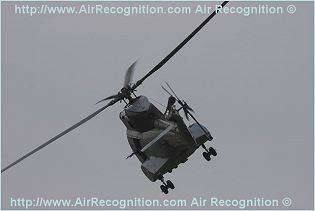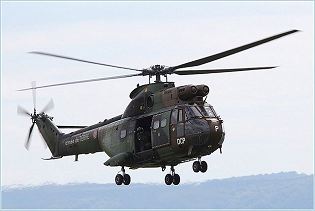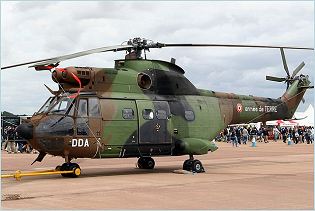SA330 Super Puma Eurocopter
| a | ||||||||||||||||||||||
|
SA 330 Puma All-weather tactical transport helicopter
|
||||||||||||||||||||||
|
|
||||||||||||||||||||||
|
|
||||||||||||||||||||||
|
The SA 330 Puma is an All-weather tactical transport helicopter developed, designed and manufactured by the French Company Sud Aviation, and continued to be produced by Aérospatiale. In the early 1960s Sud-Aviation began the design and development of a twin turbine-powered helicopter that would not only meet a French army requirement for an all-weather tactical and logistic transport, but which would be suitable also for use by other armed forces. The first of two prototypes made its maiden flight on 15 April 1965, and the Anglo-French helicopter agreement (concluded on 2 April 1968) gave Westland Helicopters in the UK joint production of these aircraft. Intended initially for service with the French army and the British Royal Air Force, the latter required this helicopter for deployment as a tactical transport. The Puma would receive its civil certification the year after the first machine was delivered to the French Army, in 1969. The first Puma would be delivered to the RAF in 1971. The South Africans also developed a similar helicopter using various components of the Puma. Known as the Oryx, the aircraft first entered service in 1988. A total of 705 Pumas would be delivered, without counting the versions manufactured in Indonesia and Romania. The SA 330 Puma being capable of carrying 18 troops with full individual armament plus three of crew. |
||||||||||||||||||||||
| Main Variants | ||||||||||||||||||||||
|
- SA 330B: for the French army and air force powered by by Turmo III C4 turboshaft engines with a take-off rating of 1,328 shp (990 kw).
- SA 330E: version for the British Royal Air Force powered by by Turmo III C4 turboshaft engines with a take-off rating of 1,328 shp (990 kw). - SA 330C/H: military export versions, first flown in September 1968, had originally 1,400-shp (1044-kW) Turmo IVBS but from the end of 1973 SA 330H aircraft were equipped with 1,575 shp (1174-kW) Turmo 1VC engines which include anti-icing of the engine air intakes. - SA 330 F/G: civil versions had Turmo IVA engines of 1,435 shp (1070-kW) as first flown on 26 September 1969 and delivered from the end of 1970. - SA 330 J: Accommodation of the SA 330J provides for a standard crew of two on the flight deck, and the cabin can have 8, 9, or 12-seat VIP layouts, or can seat up to 20 passengers in a high-density configuration, with a toilet and baggage compartment at the rear of the cabin. Equipped with thermal de-icing of the main rotor blades, thermal anti-icing of the tail rotor blades, special intakes and weather radar, the SA 330J can be flown in all weather conditions, including known icing conditions, since receiving certification in this form on 25 April 1978. - IAR 330: This is a licence-built version of the SA 330 Puma manufactured by Industria Aeronautica Româna of Romania. Designated SA 330L by the Company Aerospatiale. |
||||||||||||||||||||||
| Technical Data | ||||||||||||||||||||||
| Design | ||||||||||||||||||||||
|
The fuselage of the SA 330 Puma, as this aircraft has been named, is a conventional all-metal semi-monocoque structure, with the powerplant mounted externally on top of the fuselage shell and forward of the main rotor assembly.
|
||||||||||||||||||||||
| Avionic and defence systems | ||||||||||||||||||||||
|
The latest versions of SA 330 Puma are equipped with NVG (Night Vision Goggles) compatible glass cockpit is equipped with an advanced avionics suite integrating a cockpit interface unit (CIU) for in-flight editing of navigation points, inertial navigation system / GPS (INS/GPS) with digital moving map and modular integrated display and sight helmet (MIDASH). The SA 330 Puma can be also fitted with electro-optical pod houses a CCD TV camera, forward-looking infrared (FLIR) system and a laser range-finder, integrated with a turret mounted gun and anti-tank missiles.
|
||||||||||||||||||||||
| Propulsion | ||||||||||||||||||||||
|
The SA 330 Puma is powered by two 1,575-shp (1174-kWI Turbomeca Turmo IVC turboshafts. The rotor is driven via a main gearbox, with twin free-wheeling spur gears to combine the outputs of the two turboshaft engines to a single main drive shaft. In the event of an engine failure the remaining engine continues to drive the rotor, and should both engines fail the auto-rotating main rotor continues todrive the auxiliary take-offs for the shaft-driven tail rotor, alternator, dual hydraulic pumps, and ventilation fan. The tail boom, which carries the flapping-hinge five-blade tail rotor on the starboard side and a horizontal stabilizer on the port side, is a monocoque continuation of the aft fuselage. Early main rotor fibre and honeycomb construction, with anti-abrasion leading edges of stainless steel. The landing gear is of the semi-retracting tricycle type, with twin wheels on each unit, all of which are partly exposed when retracted.
|
||||||||||||||||||||||
| Armament | ||||||||||||||||||||||
|
The Sa 330 Puma can be armed in option with pintle mounted 7.62mm machine gun, side-firing 20mm cannon, anti-tank missiles and rockets.
|
||||||||||||||||||||||
| Specifications | ||||||||||||||||||||||
|
||||||||||||||||||||||
 |
||||||||||||||||||||||
|
||||||||||||||||||||||
































